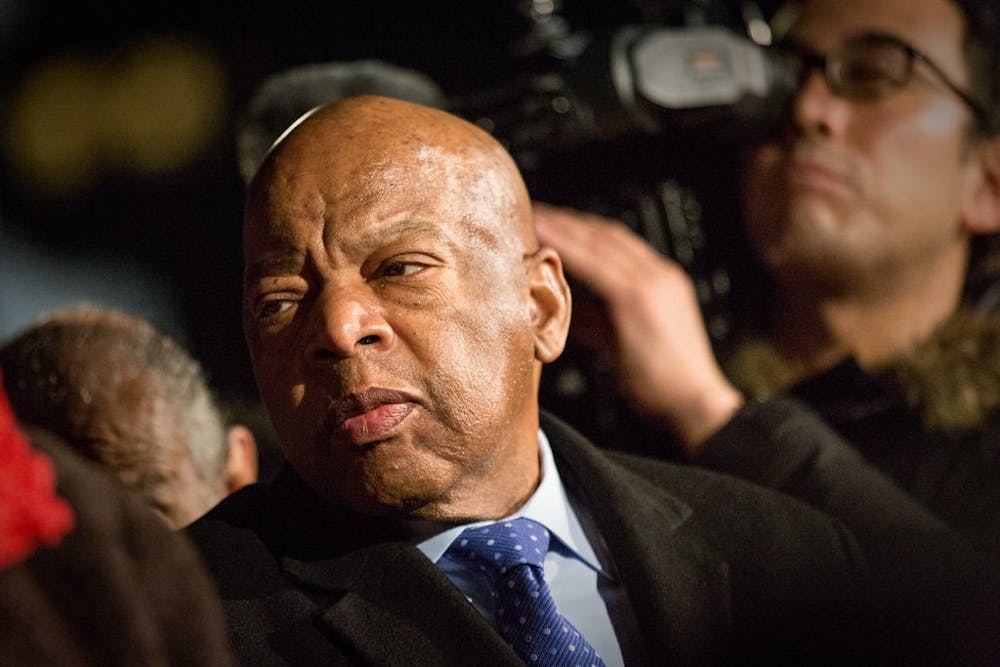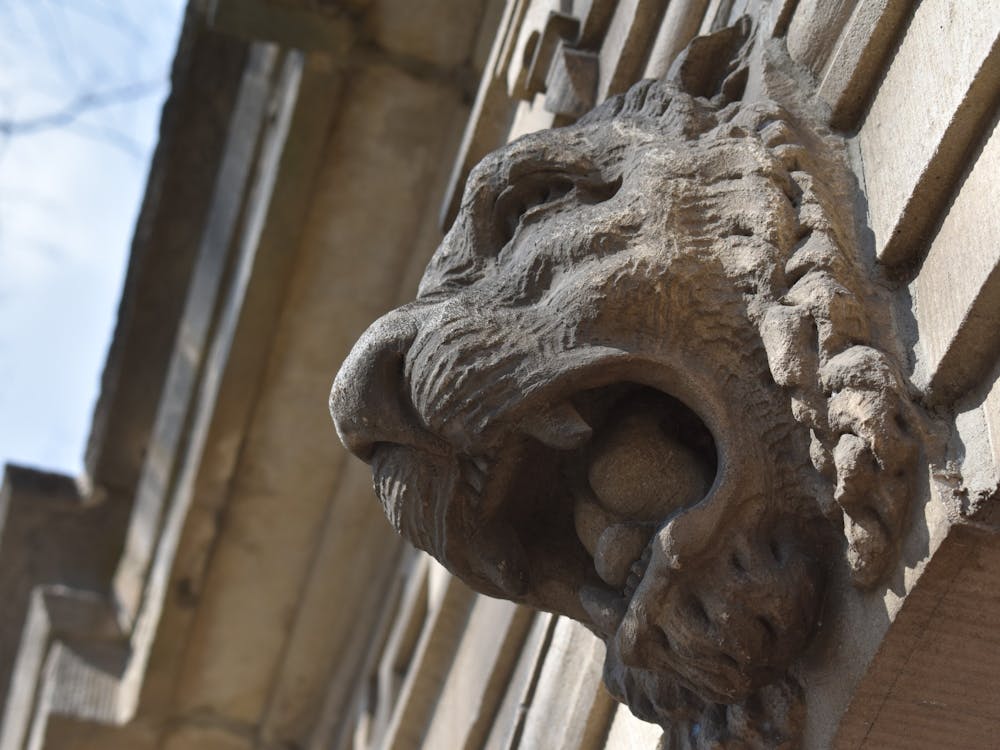In August 1963, a 23-year-old John Lewis spoke before a crowd of hundreds of thousands, advocating for racial equality. Nearly 60 years later, an 80-year-old Lewis made his final public appearance, visiting the newly-named Black Lives Matter Plaza in Washington, D.C. He stood on the large yellow letters painted on the street wearing a hat with “1619” and “400 years” stitched on it, a veteran of one massive movement for civil rights now witnessing a resurgent wave of struggle.
John Lewis spent his entire life fighting for the same cause: equal treatment for Black people. This endless battle says as much about Lewis’ character — his tenacity, his faith, his dedication — as it does about his country and its stubborn refusal to make true on its most basic promises. As we stand amidst our own generational protest movement, we should take two crucial lessons from Lewis’s life: young people change the world, and they make change through what Lewis called “good trouble.”
The tributes following John Lewis’s passing make clear that a man who looms so large in history, who achieved feats and endured adversity almost too incredible to fathom, was incredibly human. His own reflections of fear and resolve during the Civil Rights Movement, and images of Lewis dressed in the outfit he wore during the march from Selma to Montgomery leading kids in a march around Comic-Con, show how Lewis is remarkable not because he is an extraordinary figure, but because he is just a man who was radically dedicated to doing what is right. His commitment reminds us that we could be him, if we too dedicate ourselves to justice. That is the lesson of his life.
In the recent documentary “Good Trouble,” Lewis explains, “my philosophy is very simple: when you see something that is not right, not fair, not just, say something, do something, get in trouble, good trouble, necessary trouble.” It is indeed a simple philosophy, but one that is all too easy to neglect in a time of performative and superficial activism.
Over the course of his life, Lewis was arrested at least 45 times, by his count, including five times while a member of Congress. We must understand that the very actions for which Lewis is lauded today — marching, protesting, speaking out for change — branded him a criminal in the eyes of the law and government at the time.
Today, we are in the very same fight. Lewis talked about police brutality in his March on Washington speech in 1963. In a line that could have been spoken by a protester today, Lewis told the crowd, “We are tired. We are tired of being beaten by policemen. We are tired of seeing our people locked up in jail over and over again.” The night Lewis died, unmarked federal agents were marauding around Portland, bombarding protesters with tear gas and rubber bullets and rounding them up without explanation.
These tactics have escalated tensions there, and the Trump administration is planning to expand such forces to cities across the country. Like the police response to the Civil Rights Movement, the federal government is creating tension and violence in an effort to brand protesters as the disrupters. We must reflect on John Lewis’s legacy, not only by looking back on his life, but by carrying his philosophy into the present, drawing on his resolve to empower us today.
Everyone likes to say they would have supported and participated in the Civil Rights Movement; everyone is eager to voice their admiration for Lewis now. But there is a very simple way to test the sincerity of these claims: what are you doing today, at this moment, during the largest protest movement in American history?

Are you excusing the police, saying the protesters are going too far and asking for too much? Are you condemning the violent police response to protesters this summer with the same strength you decry the brutality police used during the 1960s? Are you suggesting that the young people powering this movement should sit back and listen to their elders? If you are doing any of those things, you cannot honestly claim to support John Lewis.
The tactics of the Civil Rights Movement were extremely unpopular at the time. Sixty-one percent of Americans disapproved of the Freedom Riders in 1961. Fifty-seven percent said sit-ins, freedom buses, and other demonstrations would hurt Black people’s chance of being integrated in the South. Lewis’s life reminds us that what is popular and what is right do not always align. It is far easier to commend someone in retrospect when doing so is politically safe; what really matters is where you stand when history is unfolding. In the 1960s and today, many people fail to stand on the right side of history.
The reason Lewis had to wage the same fight for nearly all his life is because defenders of the status quo resisted change. In his March on Washington speech in 1963, which other civil rights leaders persuaded him to tone down from its original rhetoric, Lewis emphasized the need for urgency, imploring the audience, “To those who have said, ‘Be patient and wait,’ we have long said that we cannot be patient. We do not want our freedom gradually, but we want to be free now!” This statement emphasizes the necessity of disrupting the status quo to achieve change, and how insistence on “order” stands in the way.
Today, both on campus and across the country, we face a similar crossroads: will we insist on maintaining the status quo, ignoring the injustice that exists, or will we recognize the necessity of disrupting that unequal status quo in pursuit of a truly just future?

The hypocrisy of many of the politicians who put out admiring statements following Lewis’s death as they simultaneously undo the work he sacrificed for highlights the necessity of understanding Lewis’s legacy in today’s context.
Lewis fought and nearly died to expand access to the vote. Today’s Republican Party is dedicated to restricting that right as much as legally possible. Congressional Republicans such as Sen. Mitch McConnell (R-Ky.) and Rep. Kevin McCarthy (R-Calif.) hailed Lewis’s suffering and endurance, admiring that he “kept working,” despite the resistance he faced.
But over the past decade, they have been the reason Lewis had to keep working. Both men oppose legislation that would reestablish the protections of the Voting Rights Act, which the Supreme Court gutted in 2013 in Shelby County v. Holder (which Lewis warned about during Chief Justice John Roberts’ confirmation). The Court’s resulting decision, in Lewis’s words, “destroyed what I considered to be the heart and soul of the Voting Rights Act.”
Like police brutality, there is a straight line between Lewis’s protest in the 1960s and his advocacy today. If we want to truly honor his memory, we must take up the fight. Much of today’s conservative philosophy, which underlies the Shelby decision and their opposition to increasing voter access, rests on the idea that racism is a thing of the past. But Lewis reminded us that “we must accept one central truth as participants in a democracy: Freedom is not a state; it is an act.”
John Lewis’s last appearance captured 2020: Lewis, masked, standing on the large yellow text “Black Lives Matter,” symbolizes a government that not only fails but refuses to protect its citizens. A man, aged and weakened by cancer but obstinate and authoritative as ever, looking out at the next chapter, the next phase of this country’s perpetual internal struggle. In an interview last month, Lewis said, “we need the energy, the commitment and dedication, of all people, but especially young people.”
We must carry on without John Lewis, but if we ever hope to make this nation's promise true, we must carry his legacy within us: disrupt the status quo, follow your conscience with morality as your north star regardless of popular sentiment, and never give up the pursuit of what is right. For us students, Lewis’s legacy is especially resonant. As John Lewis reminded us, one is “never too young or too old to get in good trouble, necessary trouble.”
Julia Chaffers is a junior from Wellesley, Mass. She can be reached at chaffers@princeton.edu.








